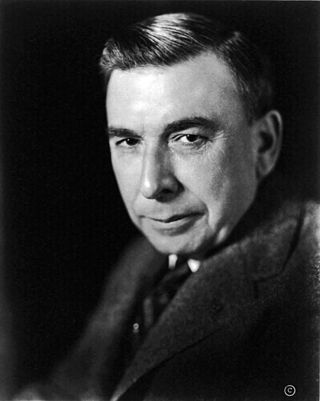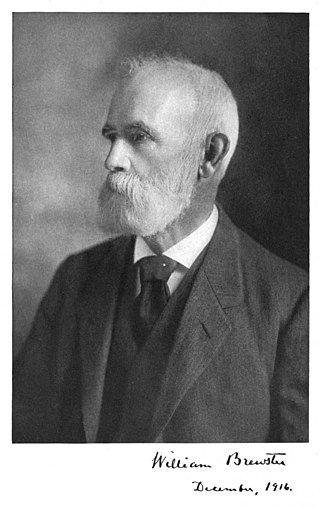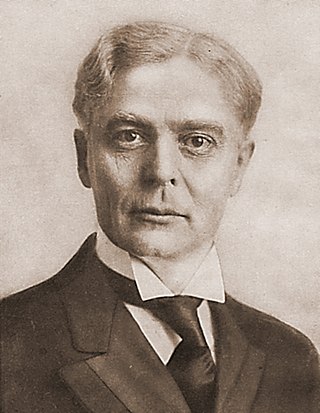Related Research Articles

Bertrand Arthur William Russell,3rd Earl Russell,was a British mathematician,philosopher,logician,and public intellectual. He had a considerable influence on mathematics,logic,set theory,linguistics,artificial intelligence,cognitive science,computer science and various areas of analytic philosophy,especially philosophy of mathematics,philosophy of language,epistemology,and metaphysics.

Newton Booth Tarkington was an American novelist and dramatist best known for his novels The Magnificent Ambersons (1918) and Alice Adams (1921). He is one of only four novelists to win the Pulitzer Prize for Fiction more than once,along with William Faulkner,John Updike,and Colson Whitehead. In the 1910s and 1920s he was considered the United States' greatest living author. Several of his stories were adapted to film.

Scott Nearing was an American radical economist,educator,writer,political activist,pacifist,vegetarian and advocate of simple living.

Daniel Coit Gilman was an American educator and academic. Gilman was instrumental in founding the Sheffield Scientific School at Yale College,and subsequently served as the second president of the University of California,Berkeley,as the first president of Johns Hopkins University,and as founding president of the Carnegie Institution. Eponymous halls at both Berkeley and Hopkins pay tribute to his service. He was also co-founder of the Russell Trust Association,which administers the business affairs of Yale's Skull and Bones society. Gilman served for twenty five years as president of Johns Hopkins;his inauguration in 1876 has been said to mark "the starting point of postgraduate education in the U.S."

Percival Proctor Baxter was an American politician and philanthropist from Maine. The son of canning magnate and Portland,Maine mayor James Phinney Baxter,he served as the 53rd Governor of the U.S. state of Maine from 1921 to 1925. A noted philanthropist,he donated several pieces of land to the public domain including Baxter Woods (Portland),Mackworth Island State Park (Falmouth),and Baxter State Park.

Bainbridge Colby was an American politician and attorney who was a co-founder of the United States Progressive Party and Woodrow Wilson's last Secretary of State. Colby was a Republican until he helped co-found the National Progressive Party in 1912;he ran for multiple offices as a member of that party,but never won.

William Brewster was an American ornithologist. He co-founded the American Ornithologists' Union (AOU) and was an early naturalist and conservationist.

The first Red Scare was a period during the early 20th-century history of the United States marked by a widespread fear of far-left movements,including Bolshevism and anarchism,due to real and imagined events;real events included the Russian 1917 October Revolution and anarchist bombings. At its height in 1919–1920,concerns over the effects of radical political agitation in American society and the alleged spread of socialism,communism and anarchism in the American labor movement fueled a general sense of concern.

William Estabrook Chancellor was an American academic and writer. An opponent of the 1920 Republican presidential candidate,Warren G. Harding,Chancellor gained notoriety when he allegedly wrote a study of Harding's ancestry just prior to the election,asserting that Harding had an African-American ancestor. Chancellor denied authorship,and it has never been proved. Two years later,a biography of Harding was published under Chancellor's name,but Chancellor denied authorship of that as well.

Charles Edward Russell was an American journalist,opinion columnist,newspaper editor,and political activist. The author of a number of books of biography and social commentary,he won the 1928 Pulitzer Prize for Biography or Autobiography for The American Orchestra and Theodore Thomas.

Ole Hanson was an American politician who served as mayor of Seattle,Washington from 1918 to 1919. Hanson became a national figure promoting law and order when he took a hardline position during the 1919 Seattle General Strike. He then resigned as mayor,wrote a book,and toured the lecture circuit,earning tens of thousands of dollars in honoraria lecturing to conservative civic groups about his experiences and views,promoting opposition to labor unions and Bolshevism. Hanson later left Washington and founded the city of San Clemente,California in 1925.

Elmer Drew Merrill was an American botanist and taxonomist. He spent more than twenty years in the Philippines where he became a recognized authority on the flora of the Asia-Pacific region. Through the course of his career he authored nearly 500 publications,described approximately 3,000 new plant species,and amassed over one million herbarium specimens. In addition to his scientific work he was an accomplished administrator,college dean,university professor and editor of scientific journals.

Warren G. Harding's tenure as the 29th president of the United States lasted from March 4,1921 until his death on August 2,1923. Harding presided over the country in the aftermath of World War I. A Republican from Ohio,Harding held office during a period in American political history from the mid-1890s to 1932 that was generally dominated by his party. He died of an apparent heart attack and was succeeded by Vice President Calvin Coolidge.
Fenwicke Lindsay Holmes (1883–1973) was an American author,former Congregational minister,and Religious Science leader. The brother of Ernest Holmes,Fenwicke is widely recognized for being an important factor in the establishment of Religious Science and the founding of the United Centers for Spiritual Living. Fenwicke is recognized as an important figure in the development of the New Thought movement in Japan in particular Seicho-no-Ie.
John Hodgdon was an American politician and farmer. The Hodgdon family were primarily farmers;his grandfather owned a significant tract of land in then disputed Aroostook County. John Hodgdon's grandfather died in 1819 and left his grandson the land,which eventually became the town of Hodgdon. His inheritance helped him attend Phillips Exeter Academy and Bowdoin College,from which he graduated in 1827. After Bowdoin,he moved to Bangor,Maine to study law under prominent area lawyer Allen Gilman. In 1833,he was a member of the Executive Council of Maine and from 1834 to 1838 he was a Land Agent for the state.
Albert Fredrick Ottomar Germann was an American physical chemist,university professor,and chemical entrepreneur.

Alexandru I. Lapedatu was Cults and Arts and State minister of Romania,President of the Senate of Romania,member of the Romanian Academy,its president and general secretary.

Robert Judson Aley was an American mathematician and university president. Aley served as the fifth President of the University of Maine from January 1911 to August 1921 and then as President of Butler College in Indiana from 1921 to 1931.
References
- ↑ "Hodgdon, Daniel Russell", in Who's who in America, Volume 11 (A.N. Marquis, 1920) p. 1355
- ↑ "Calls College Red, Resigns Presidency— Dr. Hodgdon Quits Valparaiso as 'Hotbed of Bolshevism and Other Cults'", The New York Times, April 26, 1921, p1
- ↑ Author Daniel Russell Hodgdon Worldcat.org
- ↑ Maine Alumnus (February 1960) p.16